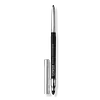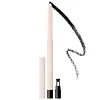Clinique Quickliner for Eyes Intense Eyeliner Versus Rare Beauty Perfect Strokes Longwear Gel Eyeliner
What's inside
What's inside
 Key Ingredients
Key Ingredients

 Benefits
Benefits

No benefits
 Concerns
Concerns

 Ingredients Side-by-side
Ingredients Side-by-side

Isododecane
EmollientCyclopentasiloxane
EmollientPEG/PPG-19/19 Dimethicone
EmulsifyingSynthetic Wax
AbrasiveHydrogenated Polydicyclopentadiene
Nylon-12
C20-40 Alcohols
EmulsifyingPerfluorononyl Dimethicone
Skin ConditioningPolyglyceryl-4 Diisostearate/Polyhydroxystearate/Sebacate
EmulsifyingPolyethylene
AbrasiveTocopherol
AntioxidantPentaerythrityl Tetra-Di-T-Butyl Hydroxyhydrocinnamate
AntioxidantIron Oxides
Mica
Cosmetic ColorantCI 77510
Cosmetic ColorantCI 77742
Cosmetic ColorantCI 19140
Cosmetic ColorantCI 77288
Cosmetic ColorantCI 77289
Cosmetic ColorantCI 75470
Cosmetic ColorantCI 77163
Cosmetic ColorantCI 77891
Cosmetic ColorantCI 77000
Cosmetic ColorantCI 42090
Cosmetic ColorantCI 77007
Cosmetic ColorantIsododecane, Cyclopentasiloxane, PEG/PPG-19/19 Dimethicone, Synthetic Wax, Hydrogenated Polydicyclopentadiene, Nylon-12, C20-40 Alcohols, Perfluorononyl Dimethicone, Polyglyceryl-4 Diisostearate/Polyhydroxystearate/Sebacate, Polyethylene, Tocopherol, Pentaerythrityl Tetra-Di-T-Butyl Hydroxyhydrocinnamate, Iron Oxides, Mica, CI 77510, CI 77742, CI 19140, CI 77288, CI 77289, CI 75470, CI 77163, CI 77891, CI 77000, CI 42090, CI 77007
Trimethylsiloxysilicate
EmollientIsododecane
EmollientSynthetic Wax
AbrasiveHydrogenated Poly(C6-14 Olefin)
EmollientHydrogenated Polydecene
EmollientHydrogenated Polyisobutene
EmollientPolybutene
Polyglyceryl-10 Pentaisostearate
EmollientPolymethylsilsesquioxane
Synthetic Beeswax
Emulsion StabilisingSilica
AbrasiveMica
Cosmetic ColorantSilica Silylate
EmollientDisteardimonium Hectorite
StabilisingPentaerythrityl Tetra-Di-T-Butyl Hydroxyhydrocinnamate
AntioxidantCopernicia Cerifera Wax
Propylene Carbonate
SolventCI 77499
Cosmetic ColorantCI 77510
Cosmetic ColorantCI 77266
Cosmetic ColorantTrimethylsiloxysilicate, Isododecane, Synthetic Wax, Hydrogenated Poly(C6-14 Olefin), Hydrogenated Polydecene, Hydrogenated Polyisobutene, Polybutene, Polyglyceryl-10 Pentaisostearate, Polymethylsilsesquioxane, Synthetic Beeswax, Silica, Mica, Silica Silylate, Disteardimonium Hectorite, Pentaerythrityl Tetra-Di-T-Butyl Hydroxyhydrocinnamate, Copernicia Cerifera Wax, Propylene Carbonate, CI 77499, CI 77510, CI 77266
Ingredients Explained
These ingredients are found in both products.
Ingredients higher up in an ingredient list are typically present in a larger amount.
This ingredient is used to impart a blue color. It is not water-soluble.
It goes by two different names:
1. Ferric Ferrocyanide: a synthetic dark blue pigment
2. Ferric Ammonium Ferrocyanide: a synthetic blue pigment, also called Prussian blue
In the EU, both of these colors must be labeled as 'CI 77510'.
Learn more about CI 77510Isododecane is a fragrance, emollient, and solvent.
As an emollient, it helps your skin stay soft and hydrated. Emollients help trap moisture into your skin.
Isododecane's role as a solvent makes it a great texture enhancer. It spreads smoothly on skin and does not leave a sticky feeling behind. Isododecane also helps prevent color transfer in makeup products.
Isododecane is not absorbed into skin.
Learn more about IsododecaneMica is a naturally occurring mineral used to add shimmer and color in cosmetics. It can also help improve the texture of a product or give it an opaque, white/silver color.
Serecite is the name for very fine but ragged grains of mica.
This ingredient is often coated with metal oxides like titanium dioxide. Trace amounts of heavy metals may be found in mica, but these metals are not harmful in our personal products.
Mica has been used since prehistoric times throughout the world. Ancient Egyptian, Indian, Greek, Roman, Aztec, and Chinese civilizations have used mica.
Learn more about MicaPentaerythrityl Tetra-Di-T-Butyl Hydroxyhydrocinnamate (long name, huh?) is a synthetic antioxidant.
It is used to help stabilize other antioxidants or prevent the color from changing in a product.
As an antioxidant, it helps fight free-radical molecules. Free-radical molecules are capable of damaging our cells and other genetic material. Thus, antioxidants may reduce the signs of aging.
This ingredient is oil-soluble.
Learn more about Pentaerythrityl Tetra-Di-T-Butyl HydroxyhydrocinnamateSynthetic Wax is created from fossil fuels such as natural gas. It is used to enhance texture, adjust pH, and as an occlusive.
It may also be used as an abrasive ingredient to exfoliate the skin.
Synthetic Wax may not be fungal acne safe.
Learn more about Synthetic Wax